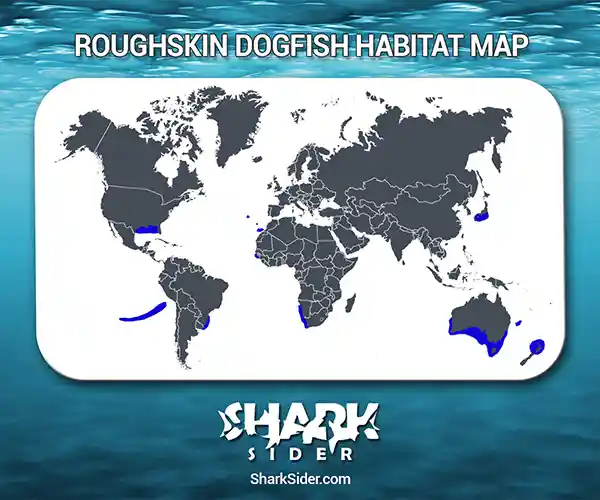The Roughskin dogfish is a member of the sleeper shark family. It is also known as Owston’s dogfish and occurs globally in tropical to temperate waters. It resembles the Portuguese dogfish.
Roughskin Dogfish Scientific Classification |
|
| Kingdom | Animalia |
| Phylum | Chordata |
| Class | Chondrichthyes |
| Order | Squaliformes |
| Family | Somniosidae |
| Genus | Centroscymnus |
| Scientific name | C. owstonii |
Description
The males can grow up to 70-79 cm (2.3-2.6 ft), while females average 82-105 cm (2.7-3.4 ft). The largest specimen on record measured 121 cm (3.9 ft).
The Roughskin dogfish appears similar to the Portuguese dogfish but has a longer snout, narrower mouth, thick lips, and smaller-cusped teeth. Its first dorsal fin is lower and longer than the second. The second dorsal fin is more triangular-shaped. The spines on both dorsal tips are exposed. The dermal denticles are also smaller and resemble bony fish scales.
These sharks have dark brown or black bodies without much tapering. The upper teeth are slender and lance-shaped, while the lower teeth are blade-like. Their nostrils have short flaps, and their large eyes are oval-shaped.
Where do they live
Map Of The Roughskin Dogfish Shark’s Habitat

They are commonly found in the Gulf of Mexico in the Atlantic Ocean. Uruguay and Brazil in the west, and the Canary Islands and from Madeira to South Africa in the east. In the Eastern Indian Ocean, they occur near Indonesia and southwestern Australia. In the Western Indian Ocean, they are spotted off the Seychelles and Madagascar islands. They also live in the Pacific around Japan, Chile, and New Zealand.
This species is a bottom-dwelling shark inhabiting the upper continental slopes at depths of 100-1,500 m (328-4,921 ft) but is more common at a depth 500-600 m (1,640-1,969 ft) below sea level.
Behavior
Dietary
Their primary diet is bony fishes and cephalopods.
Reproductive
The females are ovoviviparous and give birth to 16-28 pups per litter. Newborns are 25-30 cm (9.8-11.8 in) long. Males reach sexual maturity at 70-79 cm (2.3-2.6 ft), and females become sexually mature at 82-105 cm (2.7-3.4 ft).
Social
This species sometimes congregates in schools separated by size and sex.
Adaptations
Their eyes have a reflective layer of tissue known as a tapetum lucidum. This layer greatly enhances their vision by reflecting light into the retina and allows them to hunt efficiently in less light.
Human interactions
These sharks are a good source of squalene and fishmeal and are often caught using trawlers and longlines. Their flesh is rich in mercury and is unfit for consumption. There are no conservation efforts, and the IUCN has declared them “Vulnerable” or “VU.” In addition, they are listed as “Not Threatened” by the New Zealand Department of Conservation.
